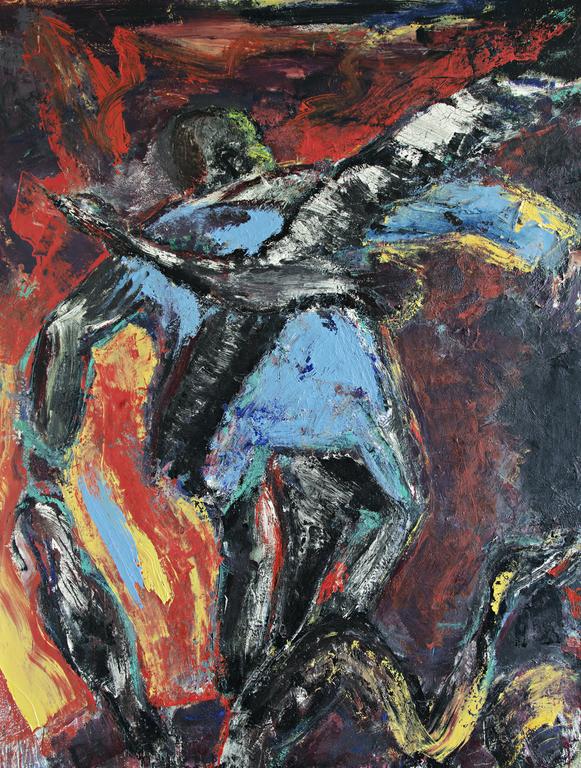Bernd Koberling: Spannweite, 1985 (Span)

Oil, synthetic resin, nettle, 115 x 140 cm
A man stands on a hill with arms spread wide open, as if wanting to jump - to take off into the colorful, shadowy unknown in front of him. In the foreground of the picture, laid over this person, a black cormorant flies. Its wings are also unfolded and their breadth measures up to the arms of the human figure. Bernd Koberling measured "spans" several times in his series "Man and Beast" (1982 to 1987) with several pictures of the same name. Each of them shows, in different forms, a human figure with arms spread wide open and a flying cormorant, which, like the human being in other paintings of this series, also appears as a single motif. This series also includes paintings of whales and beach workers. In dramatic-expressive brushwork, they all illustrate the tension between man and landscape, the vital and untouched nature and its transformation by man - and how precarious their relationship to one another is.
Bernd Koberling (*1938 in Berlin, Germany) grew up in post-war Berlin. Today, he lives and works in this city and in Iceland. He trained as a cook and earned his living in the restaurant business in his early years. At the same time, he realized his dream and studied painting at the Hochschule für Bildende Künste in Berlin from 1958 to 1960. Together with others, Koberling founded the neo-expressionist artists' group "Vision" and belonged - like Hödicke and Lüpertz (who are also shown at the Academy) - to the first artists' self-help gallery Großgörschen 35. This gallery was an experiment and one of the first self-help galleries at all, and the godfather of further such projects. The young painters wanted to set an example against the rigid established art business.
Bernd Koberling quickly became successful: he taught painting at the University of Fine Arts in Hamburg and at the University of the Arts in Berlin. In the 1980s, he became particularly well known as one of the "fathers" of the Neue Wilden - bright colors on large-format canvas, painting as if in a frenzy of color, became their trademark. However, this is only a part of his comprehensive oeuvre, which was created over a period of more than 60 years. His art goes back to Abstract Expressionism. He worked in different phases with picture series, which show the change in his interpretation and perception of his motives. In addition to the turbulent life in the city, he sought more and more peace and untouched nature in northern Sweden, the mountains of Lapland and Iceland, where he spent about 40 years of his life at times. Both were both a place of rest and a source of inspiration to him, so that the depiction of nature and landscape in its many facets was to become the main theme of his works.